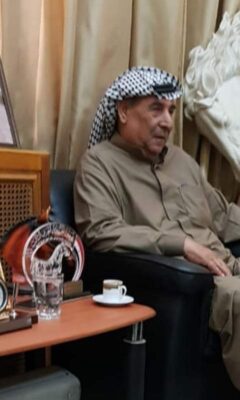Account of the Kuhaylan Da’jani horses of Khidr al-Ahmad al-Husayn, by Hammad al-Jaddu’ al-Jaz’ah of the tribe of Tai
This account recorded in early 2021. It reads like a testimony of the Abbas Pasha Manuscript. My translation:
I, Hammad Jaddu’ al-Jaz’ah, of the tribe of Tai, clan of al-Jawwalah, I am the owner of the strain of Saqlawi Dari, the horses of Jaddu’ al-Jaz’ah, in the township of Abu Hujairah, district of al-Qahtaniyah, province of al-Qamishli, governorate of al-Hasakah:
Concerning the marbat of Da’jani Kashir, the horses of Khidr al-Ahmad al-Husayn al-Juburi, they came [to Syria] at the end of 1958 or the beginning of 1959. It was the father of Khidr who came [to Syria]; his name was Ahmad al-Ali al-Juburi (of the Jubur); he was the direct son of the daughter of Ahmad al-Taha; his maternal uncle was Ahmad al-Taha. The man came from Iraq, with blood on his hands [Edouard’s note: he had killed two men there]; That’s why he crossed into Syria. There were two mares with him, a red one (bay) and a light grey one, both of the Da’jani Kashir strain, which was the marbat of his maternal uncle Ahmad al-Taha. He settled in Syria, from the beginning of 1959 until his death. To this day, his son Khidr al-Ahmad al-Juburi is around, he
inherited the marbat from his father.
Two mares came with him, a red one (bay) and a light grey one. One of them I think the light grey one, bred on. The other one did not produce anything, and both died in 1961 of the equine plague which ravaged Syria and other countries. This happened in 1961 during the time of Arab unit between Egypt and Syria, and the president of the United Arab Republic was Gamal Abdel Nasser.
The plague killed many horses that year. Both of them died in 1961 from the plague, but one of them had a filly at her side. The filly grew into a light grey, white mare; she was afflicted with lameness “Ba’jah”, hence her name “Um Ba’jah”.
It was Um Ba’jah who produced these horses the Da’jani Kashir, of the marbat of Khidr al-Ahmad al-Husayn al-Juburi. One of her offpsring was named Jalilat al-Qadr and went to Hisham Ghurayyib in Damascus. Other horses came from that line too, Nojoumieh and others. These horses, the Da’jani Kashir, the ones that came from the marbat of Ahmad al-Taha, remain present in Syria until today. There is no doubt about them, nor is there any dust; they are clean, surperior horses, steeped into Arabness (mu’arrabat) of the asil arabian horses that were present with Ahmad al-Taha at the time.
After the man came [to Syria], the census took place in 1962. They made a census of the tribes. It was then that he [Ahmad al-Husayn al-Juburi] obtained the Syrian citizenship. After he obtained the Syrian citizenship, he received a plot of land from the state; his son currently lives in the township of Qarhok Faza’; Qarhok Faza’ al-Hadi; Faza’ al-Hadi is the owner of the marbat of Hadbat Enzahi (al-Jarba); Hadbat Enzahi is owned by Faza’ al-Hadi; the man currently lives in the township of Qarhok Faza’, and the horses are still around in Syria. This is all I know about these horses. God bless you all.
As to the horses that spread from this marbat of Khidr al-Juburi, the Da’jani Kashir, one of them went to a certain Dhahir al-Salih, of the people of Garhok al-Tall; a man of the Sharabiyyin; he took a filly from Khidr al-Ahmad al-Juburi, her name is Nojoumieh; she was registered in the studbooks. This mare lives for around 30 years. She established a marbat of her own at Dhahir al-Salih, which remains to this day; horses from this marbat further spread to the interior of the country, to Damascus, Homs and Hama, even to outside the country. The sire of Nojoumieh is the Ma’naqi Hadraji of the horses of al-‘Ufaytan; the Ma’naqi Hadraji of the horses of al-‘Ufaytan. These horses did really well in the races; they were very fast; they are all famous horses.

Arnault, two more small corrections to the very detailed hujjah of Dahjani al-Arab:
https://www.allbreedpedigree.com/dahjani+al+arab
First, the Saqlawi Marzakani of Munayyis al-Saadi is Abu Ketf himself not the son of Abu Ketf;
Second, the Hadban sire of Um Ba’jah (Mabroukah) is not the same as the Hadban sire of her daughter Mukhtara. It is his father. Um Ba’jah daughter of Hadban 1, her daughter Mukhtara daughter of Hadban 2, son of Hadban 1.
This way the hujjah is complete
Thank you for this translation, and thank you to Hammad Jaddu’ al-Jaz’ah for recounting this record of the Da’jani Kashir of Khidr al-Ahmad al-Husayn. Is Nojoumieh a daughter of Um Ba’jah, or just a descendant of hers?
Nojoumieh is a grand-daughter of Umm Ba’jah, out of her daughter al-Mukhtara (the chosen one)
Bravo Edouard for your perseverance in obtaining the truth and for having collected the words of Hammad Jaddu ‘al-Jaz’ah, eyewitness of those two mares before the equine plague. I also made the corrections on the pedigree of Dahjani Al Arab in regards of the hujjah.
Our friend Radwan Shabarek considers the Al Juhaysh (Geiheish) to have very good Arabs and are particularly warlike tribes.
That’s true. The Juhaysh won a famous battled against the Shammar in 1946 near Tall Afar where the Shammar lost many men. They are still upset about it. The Juhaysh were supported by British military cars equipped with semi-automatic guns, and the Shammar were on horseback.
Thank you very much Edouard!
We can see Hammad Jaddu’ al-Jaz’ah, of the tribe of Tai, clan of al-Jawwalah as breeder and owner of the marbat sakalouieh djedranieh of Barakeh in the pedigree of Mahboob Halab.
Tha’ts right, Barakah’s dam was bred by him